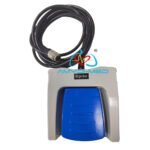
Introduction of Defibrillation Electrodes:
The conductive gel on defibrillation electrodes provides better coupling and enhanced defibrillation while adhering stably to the skin to prevent burns caused by current overload. Defibrillation electrodes use pulsed electrical currents applied to the heart to administer electric shock therapy to eliminate heart rate arrhythmias and restore the heart to sinus rhythm for extracorporeal defibrillation, resuscitation, monitoring and pacing. Compared with traditional defibrillation accessories, it can free the operator’s range of motion, and it has the advantages of high efficiency of rescue and treatment, fast action, and easy operation.
Quick Detail For Defibrillation Electrodes:
- Product name: Defibrillation Electrodes
- Product model: AMD-DD-OF0002-X
- Compatible brand: For PhysioControl lifepak 9/10/12/20/500/1000, Mindray BeneHeart D6/D3, JOUSING
- Cable material: PVC
- Cable length: 1.2m
- Plug: 4 Pin
- Logo: Neutral or customize
- Suitable for: Adult, Children
- Warranty: 12 months
Defibrillation Electrodes Technical Parameters:
- AC impedance:50 Ω(10Hz)
- DC detuning voltage:≤100mv
- Compound detuning instability and internal noise: 5min internal ≤100V (peak-to-peak)
- Defibrillation overload recovery: 5s electric potential ≤ 100mv, 30s change rate ≤ 11mV / s
- Bias current tolerance: voltage change ≤70mv
- Dielectric strength: AC1500V
- Insulation resistance: >=500 MΩ
Overview of Defibrillation Electrodes:
Basic components of defibrillation electrodes–
Defibrillation electrodes consist of electrode pads, lead wires and plugs.
Basic functions of defibrillation electrodes–
Defibrillation electrodes can be used in external defibrillation, resuscitation and pacing.
Classification of defibrillation electrodes–
Depending on the application, defibrillation electrodes can be divided into two categories, external defibrillation electrodes and internal defibrillation electrodes.
The correct placement of electrodes during defibrillation:
The placement of electrodes during defibrillation is determined by the position of the person being defibrillated, the defibrillator has 2 electrode plates, i.e. positive and negative electrodes, the positive electrode is labeled Stenal and the negative electrode is labeled Apex.
(1) The electrode plate is placed on the patient’s anterior chest wall, and most AEDs use lead II to interpret the heart rhythm.
(2) Anterior electrode: right upper chest, subclavian against the right edge of the sternum.
(3) Lateral electrode: left lower chest, the center point of electrode piece is flat axillary midline, and the upper edge does not exceed the nipple line.
Electrode sheet maintenance method:
(1) Electrode sheet should be kept clean, avoid sticking to dust, oily things, sticky things and other dirt, otherwise the adhesion will be reduced.
(2) Please paste the electrode sheet on the storage sheet for storage, do not stick it on other items to avoid damage to the electrode sheet.
(3) When the adhesion of the electrode sheet decreases due to dirt, it can be gently scrubbed with a small amount of water directly and temporarily restored after it is fully dried.
its adhesion. However, if too much water is used, the adhesiveness will be reduced.
(4) Please do not use paper towels or cloths to wipe the adhesive surface.
(5) Please do not scratch the surface with nails and brushes.
(6) Please don’t wash it frequently, please don’t use detergent or hot water.
(7) Please do not put it in direct sunlight, high temperature, humidity, dusty and corrosive gas places for storage.


